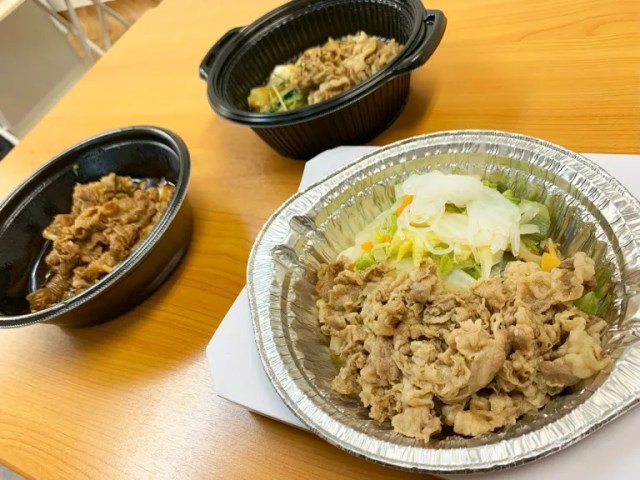
Turns out one wallet-friendly chain’s hot pot has a lot more meat.
We’re entering the best time of the year to eat sukiyaki. That’s not just because the traditional beef hot pot tastes especially good when the weather is cold, but also because late autumn and winter are the most affordable times to eat it.
Ordinarily, sukiyaki is a premium-priced meal choice. Every year in late autumn, though, a number of budget-friendly restaurant chains in Japan roll out their own suikiyaki sets, with the banners advertising the limited-time options appearing around the time the leaves start to change to their fall colors.
▼ Left to right: sukiyaki posters for Sukiya, Yoshinoya, and Yayoiken
For example, right now you can get a sukiyaki hot pot at beef bowl chain Yoshinoya, rival beef bowl chain Sukiya, and casual Japanese restaurant chain Yayoiken, all for less than 1,000 yen (US$6.70). We wondered, though, which chain’s sukiyaki set gives you the most beef, so to find out we picked up one of each and measured their meat content.
▼ Clockwise from top: Yoshinoya, Sukiya, and Yayoiken, with separate containers for the eggs that come with them.
Once we had their tops off, we grabbed a kitchen scale and a plate to weigh them on. Because this is a serious scientific research project, we wanted to ensure maximum accuracy, so we started by weighing the plate itself, determining its weight to be 8 grams (0.28 ounces).
First up was Yayoiken’s Sukiyaki Teishoku (sukiyaki set meal), which is priced at 900 yen for takeout. After transferring all of its beef to the plate, the scale read 67 grams, indicating 59 grams of beef.
Next was Sukiya’s 890-yen Gyusuki Nabe Teishoku (beef sukiyaki hot pot set meal), which tipped the scales at a startling 108 indicated grams, meaning 100 grams of beef!
This was such a big difference that we wondered if the number was being inflated by leftover drippings from the Yayoiken weigh-in, since we were using the same plate. But nope, with all of the beef removed, the plate’s weight was still just 8 grams, meaning that any moisture that had accumulated was having a negligible effect.
And last, it was time for Yoshinoya’s Gyusuki Nabezen (beef sukiyaki hot pot meal), 773 yen for takeout, which had 74 grams of beef.
So per order, you’re getting a lot more beef with Sukiya’s sukiyaki, and it’s also the best value in terms of meet-for-monetary outlay.
● Yayoiken: 15.3 yen per gram of beef
● Sukiya: 8.9 yen per gram of beef
● Yoshinoya: 10.4 yen per gram of beef
In terms of beefiness, Sukiya is an even better deal if you’re eating in, since Yayoiken and Yoshinoya charge slightly more for their eat-in sukiyaki set (950 and 787 yen, respectively) while Sukiya’s is the same price regardless of where you’re eating.
Of course, there’s more to sukiyaki than just the beef, and since we had three servings in front of us, we decided to eat them all and compare how they taste. Out of the three, Yayoiken’s broth is the sweetest and Sukiya’s the saltiest, with Yoshinoya somewhere in between. Their noodles are also slightly different. While they’re all udon, Yayoiken’s are chewier than the others’, and Yoshinoya’s have an interesting texture too, by nature of being flatter than udon noodles usually are.
Honestly, there’s not a bad pick in the bunch, but if you want the most meat, Sukiya is the one to go with.
Photos ©SoraNews24
● Want to hear about SoraNews24’s latest articles as soon as they’re published? Follow us on Facebook and Twitter!
[ Read in Japanese ]

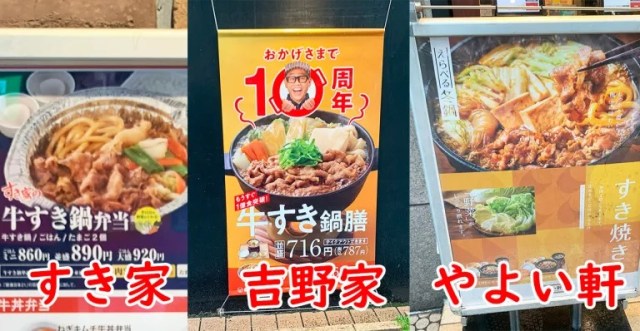
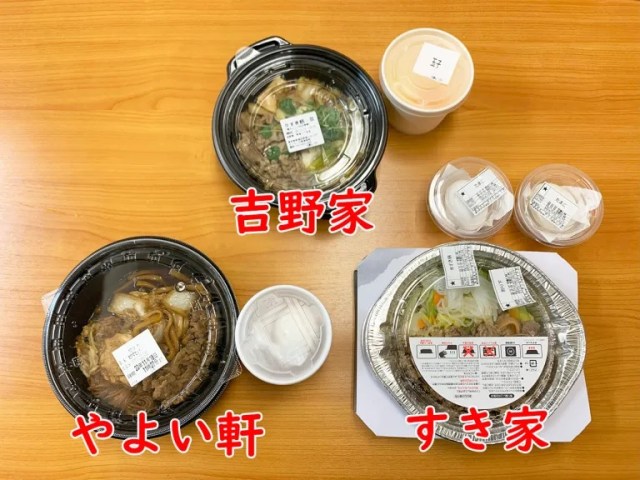
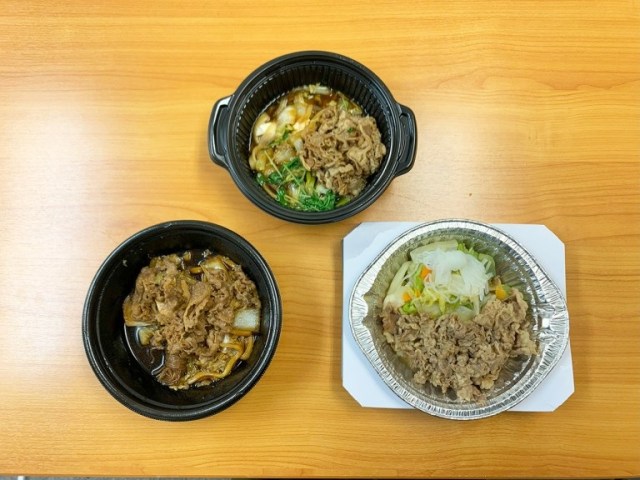

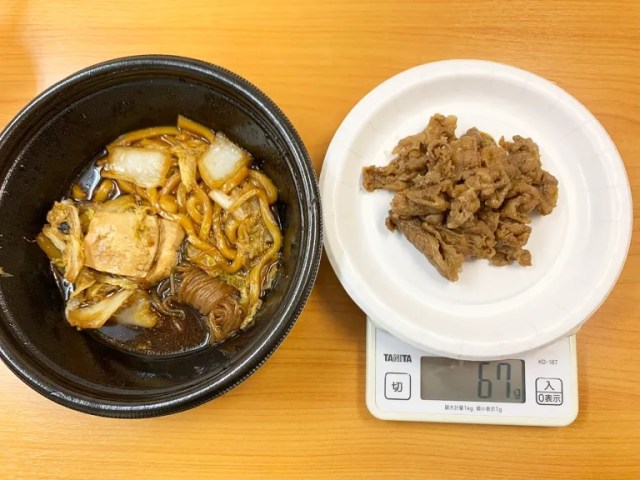
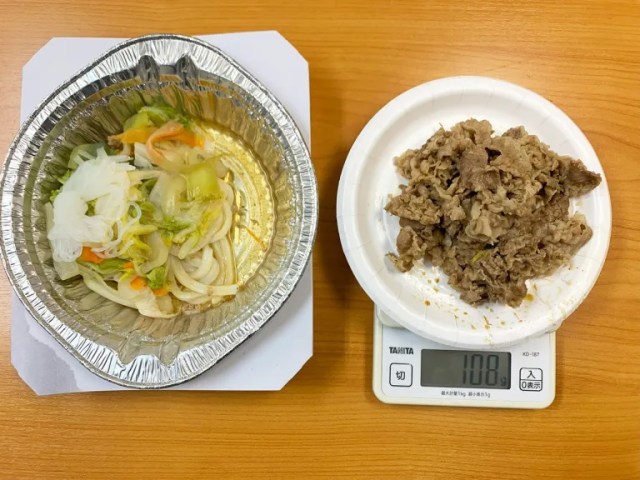
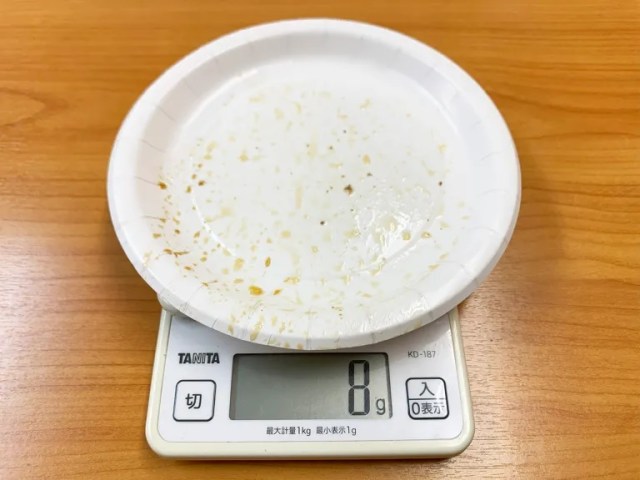

 Mix-and-matching Yoshinoya, Matsuya, and Sukiya to create the ultimate beef bowl【Taste test】
Mix-and-matching Yoshinoya, Matsuya, and Sukiya to create the ultimate beef bowl【Taste test】 Japan Super Budget Dining – What’s the best way to spend 1,000 yen at beef bowl chain Sukiya?
Japan Super Budget Dining – What’s the best way to spend 1,000 yen at beef bowl chain Sukiya? Fast food sukiyaki: One of the greatest things about autumn/winter in Japan!
Fast food sukiyaki: One of the greatest things about autumn/winter in Japan! Food Fight: We Compare Yoshinoya and Sukiya’s Pricey New Dishes
Food Fight: We Compare Yoshinoya and Sukiya’s Pricey New Dishes Kentucky Fried Sukiyaki? Japanese-style hot pots now on the menu at KFC Hong Kong
Kentucky Fried Sukiyaki? Japanese-style hot pots now on the menu at KFC Hong Kong Japanese beef bowl chain Sukiya’s 2026 Smile Box lucky bag basically pays for itself
Japanese beef bowl chain Sukiya’s 2026 Smile Box lucky bag basically pays for itself Majority of Japanese mayors say foreign residents are essential but most see good and bad effects
Majority of Japanese mayors say foreign residents are essential but most see good and bad effects The best Starbucks Japan Frappuccinos we want to drink again in 2026
The best Starbucks Japan Frappuccinos we want to drink again in 2026 Japan’s first hotel with a human washing machine is now ready for you to come and bathe in it
Japan’s first hotel with a human washing machine is now ready for you to come and bathe in it Green tea chocolate-covered potato chips arrive in Japan! 【Taste test】
Green tea chocolate-covered potato chips arrive in Japan! 【Taste test】 Four Shinto shrines to pray for love at in Japan to start the New Year
Four Shinto shrines to pray for love at in Japan to start the New Year Cup Noodle releases new Tomica “car” collection
Cup Noodle releases new Tomica “car” collection KFC Japan introduces a new burger 8 years in the making
KFC Japan introduces a new burger 8 years in the making Exhibit featuring cutting-edge smell technology held at Tokyo Skytree
Exhibit featuring cutting-edge smell technology held at Tokyo Skytree Google ad wins praise for touching on troubled history of India and Pakistan
Google ad wins praise for touching on troubled history of India and Pakistan Starbucks Japan ready to get Year of the Horse started with adorable drinkware and plushies【Pics】
Starbucks Japan ready to get Year of the Horse started with adorable drinkware and plushies【Pics】 Hayao Miyazaki says Happy New Year to Studio Ghibli fans with new art for Year of the Horse
Hayao Miyazaki says Happy New Year to Studio Ghibli fans with new art for Year of the Horse We found possibly the quietest Japanese-style hotel in Tokyo’s bustling Shinjuku district
We found possibly the quietest Japanese-style hotel in Tokyo’s bustling Shinjuku district Cup Noodle tries an authentic Jiro-style ramen, but something’s not quite right
Cup Noodle tries an authentic Jiro-style ramen, but something’s not quite right We revisited Sweets Paradise after a decade to see if Japan’s dessert buffet still delivers
We revisited Sweets Paradise after a decade to see if Japan’s dessert buffet still delivers That time Seiji called JASRAC to ask why he didn’t get paid royalties for his song being on TV
That time Seiji called JASRAC to ask why he didn’t get paid royalties for his song being on TV Japan’s oldest largetooth sawfish in captivity back on display in Mie Prefecture
Japan’s oldest largetooth sawfish in captivity back on display in Mie Prefecture Pizza Hut Japan’s hot lucky bags are perfect for a New Year’s pizza party
Pizza Hut Japan’s hot lucky bags are perfect for a New Year’s pizza party 7-Eleven Japan starts new temporary luggage storage service in over 300 branches
7-Eleven Japan starts new temporary luggage storage service in over 300 branches Disillusionment at Tsukiji’s tourist-target prices led us to a great ramen restaurant in Tokyo
Disillusionment at Tsukiji’s tourist-target prices led us to a great ramen restaurant in Tokyo Starbucks teams up with 166-year-old Kyoto doll maker for Year of the Horse decorations【Photos】
Starbucks teams up with 166-year-old Kyoto doll maker for Year of the Horse decorations【Photos】 Tokyo considering law requiring more trash cans following litter increase in heavily touristed area
Tokyo considering law requiring more trash cans following litter increase in heavily touristed area Tokyo’s Tsukiji sushi neighborhood asks tour groups to stay away for the rest of the month
Tokyo’s Tsukiji sushi neighborhood asks tour groups to stay away for the rest of the month Tokyo event lets you travel back in time, for free, to celebrate 100 years since Showa era start
Tokyo event lets you travel back in time, for free, to celebrate 100 years since Showa era start Japan may add Japanese language proficiency, lifestyle classes to permanent foreign resident requirements
Japan may add Japanese language proficiency, lifestyle classes to permanent foreign resident requirements Sanrio theme park in Japan announces plans to expand into a Sanrio resort
Sanrio theme park in Japan announces plans to expand into a Sanrio resort Stamina-destroying “Paralysis Noodles” are Tokyo’s newest over-the-top ramen innovation
Stamina-destroying “Paralysis Noodles” are Tokyo’s newest over-the-top ramen innovation Survey asks foreign tourists what bothered them in Japan, more than half gave same answer
Survey asks foreign tourists what bothered them in Japan, more than half gave same answer Japan’s human washing machines will go on sale to general public, demos to be held in Tokyo
Japan’s human washing machines will go on sale to general public, demos to be held in Tokyo Japan’s deadliest food claims more victims, but why do people keep eating it for New Year’s?
Japan’s deadliest food claims more victims, but why do people keep eating it for New Year’s? We deeply regret going into this tunnel on our walk in the mountains of Japan
We deeply regret going into this tunnel on our walk in the mountains of Japan Studio Ghibli releases Kodama forest spirits from Princess Mononoke to light up your home
Studio Ghibli releases Kodama forest spirits from Princess Mononoke to light up your home Major Japanese hotel chain says reservations via overseas booking sites may not be valid
Major Japanese hotel chain says reservations via overseas booking sites may not be valid Put sesame oil in your coffee? Japanese maker says it’s the best way to start your day【Taste test】
Put sesame oil in your coffee? Japanese maker says it’s the best way to start your day【Taste test】 No more using real katana for tourism activities, Japan’s National Police Agency says
No more using real katana for tourism activities, Japan’s National Police Agency says Starbucks Japan reveals new sakura drinkware collection, inspired by evening cherry blossoms
Starbucks Japan reveals new sakura drinkware collection, inspired by evening cherry blossoms Updated cherry blossom forecast shows extra-long sakura season for Japan this year
Updated cherry blossom forecast shows extra-long sakura season for Japan this year Which of Japan’s big three beef bowl chains has the best tonjiru pork miso soup?【Taste test】
Which of Japan’s big three beef bowl chains has the best tonjiru pork miso soup?【Taste test】 Semi-secret fried chicken from Japan’s big-three beef bowl chain Sukiya is worth tracking down
Semi-secret fried chicken from Japan’s big-three beef bowl chain Sukiya is worth tracking down One Japanese man has eaten at the same beef bowl restaurant for over 1,800 days in a row
One Japanese man has eaten at the same beef bowl restaurant for over 1,800 days in a row Japan’s new sukiyaki burger tops your burger with more beef all winter long
Japan’s new sukiyaki burger tops your burger with more beef all winter long Japan Super Budget Dining – What’s the best way to spend 1,000 yen at Yoshinoya?
Japan Super Budget Dining – What’s the best way to spend 1,000 yen at Yoshinoya? Beautiful beefy Yoshinoya gacha capsule toys look good enough to eat or display【Photos】
Beautiful beefy Yoshinoya gacha capsule toys look good enough to eat or display【Photos】 Yoshinoya adds first-ever chain-wide ramen with new beef and pork-broth noodle hot pot meals
Yoshinoya adds first-ever chain-wide ramen with new beef and pork-broth noodle hot pot meals Japan’s giant sukiyaki burgers pair beef with beef for hot pot flavor in sandwich form
Japan’s giant sukiyaki burgers pair beef with beef for hot pot flavor in sandwich form With prices in Japan rising for everything else, one beef bowl chain announces price cuts
With prices in Japan rising for everything else, one beef bowl chain announces price cuts Sukiya celebrates Tsukimi Moon-Viewing season with limited-edition gyudon beef bowls in Japan
Sukiya celebrates Tsukimi Moon-Viewing season with limited-edition gyudon beef bowls in Japan Japanese man who ate at same beef bowl chain for 2,000 days in a row announces he’s gotten married
Japanese man who ate at same beef bowl chain for 2,000 days in a row announces he’s gotten married Yoshinoya sells frozen beef bowl topping packs, but are they as good as the restaurant kind?
Yoshinoya sells frozen beef bowl topping packs, but are they as good as the restaurant kind? Japan’s beef bowl king, Yoshinoya, releases new line of canned, ready-to-eat beef bowls
Japan’s beef bowl king, Yoshinoya, releases new line of canned, ready-to-eat beef bowls This cheap Japanese beef bowl fast food chain now has beautiful, delicious frozen desserts
This cheap Japanese beef bowl fast food chain now has beautiful, delicious frozen desserts Yoshinoya has an ultra-luxurious wagyu beef bowl you can only get one place in Japan【Taste test】
Yoshinoya has an ultra-luxurious wagyu beef bowl you can only get one place in Japan【Taste test】
Leave a Reply